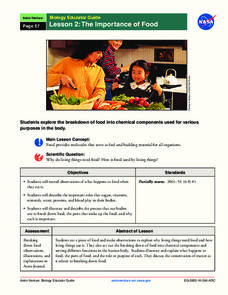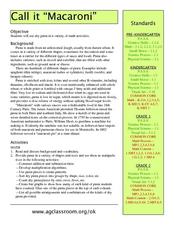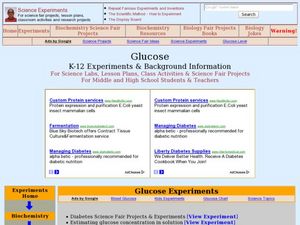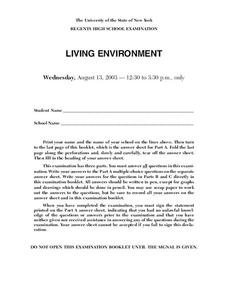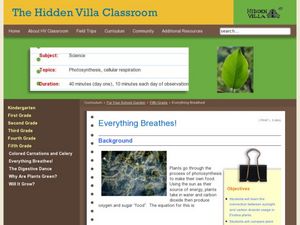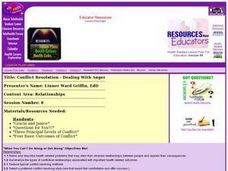Curated OER
Making Blood!
Ninth graders study facts about human blood and what it is made of. In this blood composition lesson plan students divide into groups and complete several activities.
NASA
The Importance of Food
Pupils make observations while eating food. They act out the process of food breaking down in the body and the roles of various chemical components, such as sugar and protein. It concludes with an activity illustrating the process and a...
Curated OER
The Crisco Lab: A Demonstration of Diabetic Complications
Students complete lab activities to illustrate the complications of diabetes. In this diabetes lesson, students work on labs that illustrate sugar in the blood and normal and atherosclerotic vessels. They demonstrate how diabetes can...
Curated OER
Regents High School Examination: Living Environment 2005
The 2005 version of the Regents High School Examination in the area of ecology is as comprehensive as previous years' exams. It consists of 40 multiple choice questions on everything from the structure of DNA to the interactions within...
Perkins School for the Blind
Building an Organic Molecule
Glucose is a simple sugar and a molecule that can be illustrated through modeling. Scientific investigators with visual impairments use hands-on models to reconstruct the process of bonding molecules. The tools used in this activity are...
Curated OER
Neuron Cookie
Find out just how enticing learning about neurons can be by creating models with sugar cookies, icing, and candy. With great background information for you and an easy procedure for the kids, studying cells has never been more fun or...
Curated OER
Diet: Find the Carbohydrates
Students discover and discuss the functions of carbohydrates. Once they have taken notes and completed worksheets, they perform experiments using iodine to test for starch. Lesson topics include how carbohydrates are processed by the...
Curated OER
Construction of a Hemoglobin Gene
Young scholars see how eight pairs of triplets are equivalent to part of a gene and control a part of heredity. They comprehend how blood corpuscles manufacture normal hemoglobin. Students already comprehend that genes control the...
Curated OER
Compare and Contrast Type 1 and Type 2 Diabetes
Young scholars use graphic organizers to compare and contrast Type 1 and Type 2 diabetes. In this diabetes instructional activity, students are given information on the two major types of diabetes. They analyze how to compare and...
Curated OER
Milk Makes Me Sick
Students experiment with lactase to find out how milk sugar is broken down in the body. For this enzyme lesson, students use glucose strips to investigate the breakdown of lactose into glucose and galactose for milk digestion in the...
Curated OER
CONSTRUCTION OF A HEMOGLOBIN GENE
Students use research to see how eight pairs of triplets are equivalent to part of a gene and control a part of heredity. They also understand how red blood corpuscles manufacture normal hemoglobin.
Curated OER
The Four Groups of Biologically Important Compounds
This is not they typical set of teacher instructions. It is an organized chart of the important organic compounds. For each, the involved elements, the name of the building block monomers, the names of polymers, extra information, and a...
Curated OER
Call it "Macaroni"
Who knew there were so many fun educational opportunities featuring pasta? Scholars read a brief informational text about the history of pasta (note that "macaroni" is spelled two different ways, so address this if kids are reading...
Curated OER
Glucose
High schoolers conduct various experiments on glucose. In this biology lesson, students differentiate the process of diffusion and osmosis. They test different foods for the presence of glucose and starch.
Curated OER
Living Environment
In this environmental lesson students complete a series of multiple choice and short answer questions on animal populations, cell structure and chromosomes.
Curated OER
Dealing With Diabetes
Learners read a story about a teen with diabetes. They research diabetes and glucose. They compare and contrast Type 1 and Type 2 diabetes.
Nemours KidsHealth
Diabetes: Grades 3-5
Students investigate personal health by researching healthy eating on the Internet. In this childhood disease lesson, students discuss diabetes, the causes, and ways it can be prevented. Students complete worksheets based on potentially...
Curated OER
Everything Breathes!
Fifth graders test plants in the dark and in the light to see which grows better and produces more carbon dioxide. In this plants lesson plan, 5th graders also create ways for plants to go through photosynthesis that they can observe.
Curated OER
Solving Mysteries Using Paper Chromotagraphy
Middle schoolers solve the mystery of the kidnapped teacher by analyzing a ransom note using paper chromatography. They carefully prepare ink samples from the note to known ink samples to determine the kidnapper.
Curated OER
Conflict Resolution - Dealing With Anger
Students summarize the types of conflictual relationships associated with important health related outcomes. They deduce typical conflict resolving methods. They select a preferred conflict resolving style. They role-play a situation and...
Curated OER
Man's Best Friend
Students compare human and dog senses. In this biology lesson, students describe different ways that dogs help humans. They research and create a presentation about a modern dog hero.
Curated OER
Vitamin C
Students learn and sing a song about vitamins and how important vitamin C is in a healthy diet.
Curated OER
B is for Banana
Students learn and practice the song "B is for Banana" and examine how eating bananas is important for good nutrition and health.
Curated OER
Fiber
Students learn and practice the song "Fiber," and explore the importance of fiber in a healthy diet.
Other popular searches
- Blood Sugar Regulation
- Blood Sugar Control
- Low Blood Sugar
- Algebra and Blood Sugar
- Regulating Blood Sugar
- Blood Sugar Log Book
- Controlling Blood Sugar
- Homeostasis Blood Sugar

